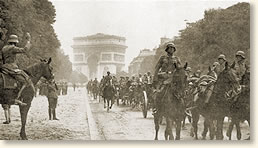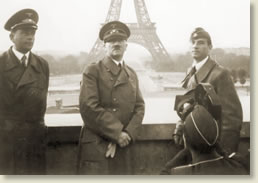|
Hitler Tours Paris, 1940
Germany's invasion of France culminated in France's
surrender in a formal ceremony held in a railroad
car in Compiegne Forest on June 22, 1940 (see France
Surrenders, 1940). The terms of the surrender called for all hostilities
to cease on June 25. Shortly after this ceremony, Hitler summoned Albert Speer
- his favorite architect - to join him at his headquarters in a small village
in northern France. The village had been cleared of its inhabitants and many
of its homes commandeered as living quarters for Hitler and his staff.
 |
German troops enter Paris
June 14, 1940 |
Upon arrival, Speer was informed by Hitler that he intended to take a tour of
Paris in a few days and wanted the architect to accompany him. Speer remained
in the village and joined Hitler and his entourage in a peasant's cottage on
the evening of the formal end of hostilities between France and Germany. As the
time of the armistice approached, 1:35 AM June 25, Hitler ordered the lights
in the home turned out and the windows opened. Sitting silently in the darkness,
Hitler and his entourage listened to a thunderstorm in the distance and to a
bugler blowing the traditional signal for the end of fighting. Hitler then ordered
the light turned back on.
Three days later, Speer accompanied Hitler as he flew in the early morning hours to an airfield near Paris.
We join Speer's narrative as he and the rest of Hitler's
entourage arrive at an airport near Paris on June 28, 1940:
"Three days after the beginning of the armistice
we landed at Le Bourget airfield. It was early in the morning, about five-thirty.
Three large Mercedes sedans stood waiting. Hitler as usual sat in the front
seat beside the chauffeur, Breker [a sculptor] and I on the jump seats behind
him, while Giessler [an architect] and the adjutants occupied the rear seats.
Field-gray uniforms had been provided for us artists, so that we might fit
into the military framework. We drove through the extensive suburbs directly
to the Opera, Charles Garnier's great neobaroque building. . . . It was Hitler's
favorite and the first thing he wanted to see. Colonel Speidel, assigned
by the German Occupation Authority, was waiting at the entrance for us.
The great stairway, famous for its spaciousness, notorious for its excessive ornamentation, the resplendent foyer, the elegant, gilded parterre, were carefully inspected. All the lights glowed as they would on a gala night. Hitler had undertaken to lead the party. A white-haired attendant accompanied our small group through the deserted building. Hitler had actually studied the plans of the Paris opera house with great care. Near the proscenium box he found a salon missing, remarked on it, and turned out to be right. The attendant said that this room had been eliminated in the course of renovations many years ago. 'There, you see how well I know my way about,' Hitler commented complacently.
He seemed fascinated by the Opera, went into ecstasies about its beauty, his eyes glittering with an excitement that struck me as uncanny. The attendant, of course, had immediately recognized the person he was guiding through the building. In a businesslike but distinctly aloof manner, he showed us through the rooms. When we were at last getting ready.to leave the building, Hitler whispered something to his adjutant, Briickner, who took a fifty-mark note from his wallet and went over to the attendant standing some distance away. Pleasantly, but firmly, the man refused to take the money. Hitler tried a second time, sending Breker over to him; but the man persisted in his refusal. He had only been doing his duty, he told Breker.
Afterward, we drove past the Madeleine, down the Champs Elysees, on to the Trocadero, and then to the Eiffel Tower, where Hitler ordered another stop. From the Arc de Triomphe with its tomb of the Unknown Soldier we drove on to the Invalides, where Hitler stood for a long time at the tomb of Napoleon. Finally, Hitler inspected the Pantheon, whose proportions greatly impressed him. On the other hand he showed no special interest in some of the most beautiful architectural works in Paris: the Place des Vosges, the Louvre, the Palace of Justice, and SainteChapelle. He became animated again only when he saw the unitary row of houses on the Rue de Rivoli.
 |
Tourist Hitler poses at the Eiffel Tower
Albert Speer is at the left. |
The end of our tour was the romantic, insipid imitation of early medieval domed churches, the church of Sacre Coeur on Montmartre-a surprising choice, even given Hitler's taste. Here he stood for a long time surrounded by several powerful men of his escort squad, while many churchgoers recognized him but ignored him. After a last look at Paris we drove swiftly back to the airport. By nine o'clock in the morning the sightseeing tour was over. 'It was the dream of my life to be permitted to see Paris. I cannot say how happy I am to have that dream fulfilled today.' For a moment I felt something like pity for him: three hours in Paris, the one and only time he was to see it, made him happy when he stood at the height of his triumphs.
In the course of the tour Hitler raised the question of a victory parade in Paris. But after discussing the matter with his adjutants and Colonel Speidel, he decided against it after all. His official reason for calling off the parade was the danger of its being harassed by English air raids. But later he said: 'I am not in the mood for a victory parade. We aren't at the end yet.'
That same evening he received me once more in the small room in the peasant house. He was sitting alone at table. Without more ado he declared: 'Draw up a decree in my name ordering full-scale resumption of work on the Berlin buildings. . . . Wasn't Paris beautiful? But Berlin must be made far more beautiful. In the past I often considered whether we would not have to destroy Paris,' he continued with great calm, as if he were talking about the most natural thing in the world. 'But when we are finished in Berlin, Paris will only be a shadow. So why should we destroy it?' With that, I was dismissed."
References:
This eyewitness account appears in: Speer, Albert, Inside the Third Reich (1970).
How To Cite This Article:
"Hitler Tours Paris, 1940," EyeWitness to History,
www.eyewitnesstohistory.com (2008).
|






